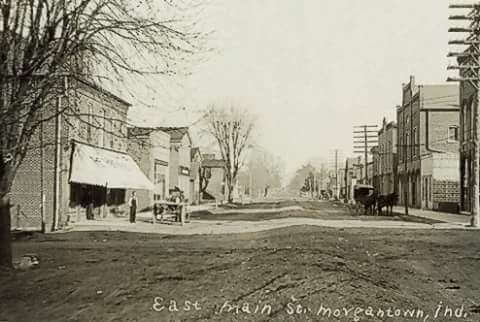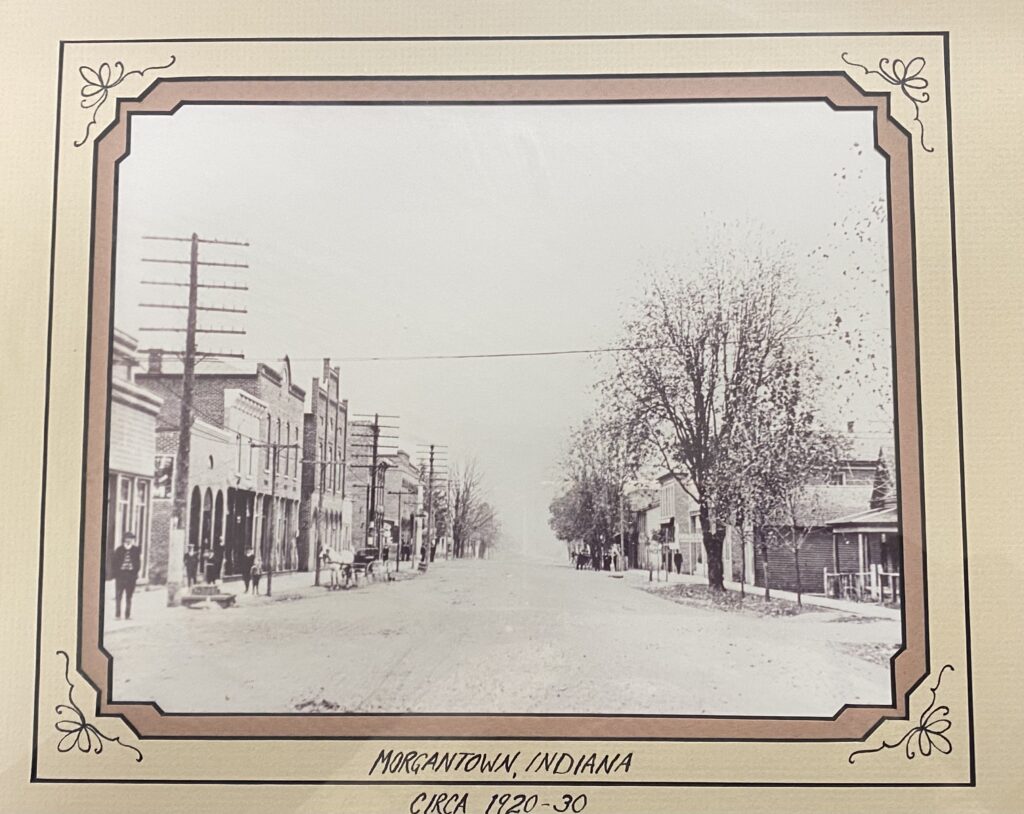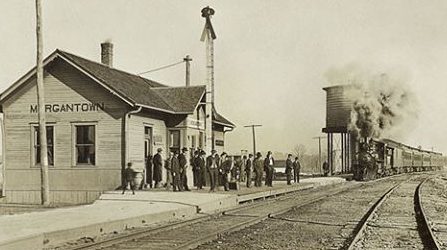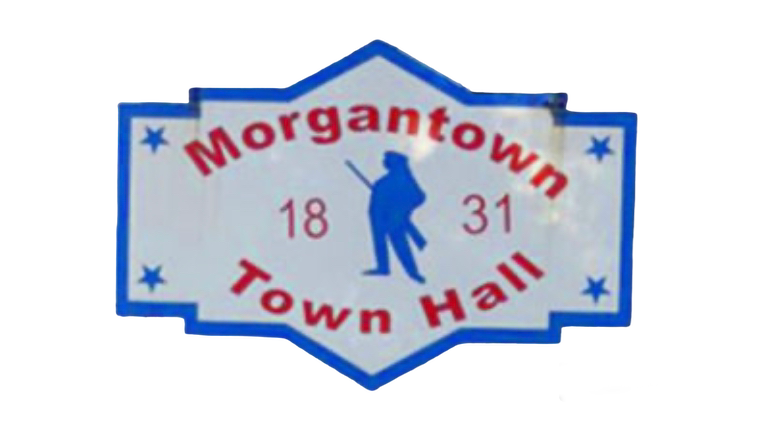Morgan County history from 1884 with information on Morgantown and Jackson Township.
History and Development
The Morgantown Historic District is eligible for the National Register of Historic Places under Criterion A and C. Bounded by Marion Street (State Road 135) on the west, it encompasses approximately six blocks on the north and south sides of Washington Street, the main thoroughfare. The district is representative of and associated with the founding, development, and maturity of a typical Indiana small town, especially in the areas of commerce, politics, and transportation. It also embodies the distinctive characteristics of a variety of types of commercial, residential, and ecclesiastical architecture ranging from Greek Revival and nineteenth-century vernacular through early-and mid-twentieth century vernacular and popular styles. The period of significance is 1840-1956, since the historical period of the town’s development was ongoing to beyond the 1950s.


The Morgantown Historic District was identified as eligible for the National Register of Historic Places in the Morgan County Interim Report (1993). It is one of four districts in the county and the last to be nominated and listed. The resource count has been changed to account for all individual building as identified through site visits and research. In addition, the district boundaries have been altered slightly to include two buildings that were omitted from the district during the 1993 survey. Consequently, this nomination has a total resource count of 54, consisting of 34 contributing buildings and 20 non-contributing buildings.
Morgantown is the only town in Jackson Township in southeastern Morgan County, nine miles east of the county seat of Martinsville, at the intersection of State Roads 252 and 135. With forested areas punctuated by tilled fields and residential subdivisions, the northern two-thirds of the township is gently rolling. The southern one-third, relatively hilly and wooded, is cut through by Indian Creek and several smaller creeks. Indian Creek touches Morgantown on its south boundary. The Illinois Central Railroad parallels the Johnson County line in the southeast, entering Morgantown on its east end.
Platted in 1831 by Robert Bowles and Samuel Teeters, Morgantown originated as a mill town on Indian Creek comprised of 52 lots roughly one-fifth acre in size, beginning at Church St. on the east and centered on Washington Street. A portion of the plat is today’s historic district. The entire area was replatted by Isabelle Teeters and Colonel John Vawter in 1836.
The town grew slowly during its formative years. A corn cracker was built by Joshua Whitley about 1830, followed by two other mills which operated on Indian Creek. The first post office was established in 1833. By 1835, postmaster John Fee was operating a dry goods store and linseed oil mill, and Vawter was proprietor of a general store. Other businesses, including wagon shops, a blacksmith, woolen mill, and cabinet shop, provided essential needs to about 15 families, or 70 residents, and others in the surrounding area. The first frame school was built in 1840, the same decade that the Methodist and Christian churches were organized. The Baptist Church followed in 1850.
The coming of the Martinsville-Franklin Flatbar Railroad in 1853, and its extension to Fairland (thereinafter called the Big Four) following the Civil War, had a dramatic impact on Morgantown. James McCallister built a wool carding mill in the 1850s, and William Hickey established a plug tobacco business in the 1860s. The increase in population and demand for building lots led, in 1859, to the first addition to the city north and east of the original plat. In the 1870s, a fine brick school building was erected and the early church buildings were replaced with more permanent buildings, among them was the Christian Church (018) built in 1871.

By 1880, the town’s population had reached over 600, and new businesses, attracted by ready access to the rail line, were thriving. The discovery of a natural gas well marked the beginning of municipal improvements.
The Morgantown Historic District along Washington Street represents this early period of prosperity. The earliest buildings are the Greek Revival-influenced I-houses at 149 E. Washington Street (035, built c.1840) and 49 E. Washington St. (029, built 1851 or 1852).
Other mid-nineteenth-century buildings include the Greek Revival Obenshain Hotel at 160 W. Washington St (003, built 1860) and the Parkhurst House at 120 E. Washington St. (017, built 1865). Post-Civil War residential construction is represented by the Roberts House at 130 W. Washington St. (005, built 1870), a blend of Greek Revival and Italianate styles and a side hall plan, and the Italianate style house at 129 E. Washington St. (033, built c.1875).
The 1890s constituted a major period of rebuilding following an 1894 fire that destroyed all of the buildings on the south side of Washington St. between Marion and Cross St. Rebuilding began immediately, with the Masonic Lodge (020) and Mitchell Hardware (021), both built 1894, among the first buildings to go up. In 1895, Dr. R. C. Griffitt tore down his father’s store and post office and rebuilt a fine Queen Anne style house (008) on the same site.
Fire and rebuilding also characterized the first decades of the twentieth century. In 1908, fire destroyed all of the buildings on the south side of Washington St. between Cross and Church St. The G. W. Crawford Building (025-A), constructed in 1910, was the first to go up, followed, in 1914, by Woods Dodge/Plymouth Dealership (024) and the Ezra Shultz Building (024-B), later the Woods Annex. Morgantown soon prospered with the establishment of an electric light plant (and its improvement following a 1903 crash) and telephone system (c.1900), founding of the first bank (1900), installation of the first concrete sidewalks (1907), the arrival of the Indiana Southern Railroad (Illinois Central after 1927) in 1910 and, about the same time, the founding of Fulsmore Furniture Manufacturing Company, which became Faucett Umphrey Chair Company in 1916. Among the buildings that present this prosperity are the Telephone Exchange (028), built in 1906, the 1903 Odd Fellows Lodge (019)—whose first floor served as Red Cross headquarters during World War I–, the 1908 Redmen’s Lodge (026), and O. O. Elkins Ice House (039), built in 1914.
The 1920s, 1930s, and 1940s were a period of maturity. Town government moved into a permanent home in Town Hall (006, built c.1900) in 1925. Redevelopment occurred on E. Washington St. with remodeling of the Methodist Church and construction of the new Community Hall (both 012) in 1923, and the replacement of older housing stock with new styles. The 1926 Miller House, a stucco covered bungalow at 60 E. Washington St. (014) is a good example. Enhancement of infrastructure was marked by installation of a municipal water system in 1927. The Wisby Hotel (027), built in 1923, represents the beginning of Morgantown’s transition from a self-supporting, self-sustained village to a stopover for tourists to and from Nashville and Brown County. Increasing reliance on automobiles is reflected in the number of private and commercial garages, the founding of Whitaker Chevrolet in 1933, and the paving of State Road 135 in 1941. Highway travel soon trumped travel by rail, with Scenic Bus Lines service available to and from Indianapolis, Nashville, and Camp Atterbury, resulting in the pull- out of the Big Four in 1945. The post-war years also brought new construction: Lonyo Liquor Store (022-A) in 1945 and Haase Liquor Store (002-A) in 1954.
By the 1950s and 1960s, Morgantown had attained an uneasy balance of stability and decline. Redevelopment occurred in the downtown area with the replacement of Whitaker’s Store with the Cowden building (023) in 1957; the demolition of Graham Lumber Company at the corner of Washington and Church St.; and the replacement of the two buildings on the southeast corner of Washington and Marion St. with a Pure Oil station. Long-established businesses began to close, among them the Morgantown Packing Company canning plant about 1950, Woods Dodge/Plymouth in 1958, Faucett Umphrey Chair Company in 1962 or 1963. The high school closed in 1967 (the grade school followed 20 years later). It was during this period that the rural fire department—it was not yet a municipal fire department–moved into the Crawford and Woods Annexes; the bank moved into its new Neoclassical home; and Blanche Crawford, who designed and supervised the new bank building, built the house at 139 E. Washington St. (034- A)—the youngest resource in the district.
By the 1970s, buildings had gone without conscientious and regular maintenance for several decades, and, generally speaking, both businesses and homeowners rotated on a steady basis. By the mid-1980s, Morgantown residents began to envision a new chapter in the town’s history patterned after that of nearby Nashville. Morgantown could become a tourist destination—or at least a stop on the way to Nashville. The Chamber of Commerce was formed in the 1980s, followed in the 1990s by the Morgantown Merchants Association, whose primary objective was downtown revitalization and improvement. A Project Main Street grant funded tree planting, improvements to sidewalks and gutters, improvement of the Illinois Central Railroad crossing,and the construction of public restrooms behind Town Hall. The 2000s have been characterized by a continuing earnestness for improvement, increased emphasis on tourism, and celebration and promotion of Morgantown’s unique cultural heritage.

